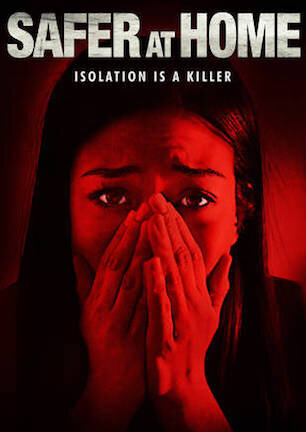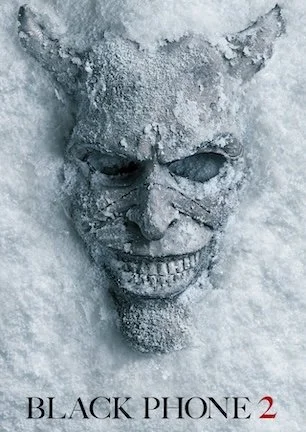Studio: Vertical Entertainment
Director: Will Wernick
Writer: Will Wernick, Lia Bozonelis
Producer: Bo Youngblood, John Ierardi, Will Wernick
Stars: Jocelyn Hudon, Alisa Allapach, Dan J. Johnson, Adwin Brown, Daniel Robaire, Emma Lahana, Michael Kupisk
Review Score:
Summary:
Two years into the COVID pandemic, a group Zoom call takes a turn into paranoia after seven friends take psychedelic drugs.
Review:
A few days before quarantine-themed thriller “Safer at Home” debuted, CNN happened to run an article about how TV shows in 2021 are making more episodes about COVID, which is causing a number of viewers to tune out. In examining both sides of this trend, an assistant professor for brain studies at Indiana University stated, “The question of whether reliving experiences related to coronavirus is positive and helping us to cope or triggering is very complicated.” One showrunner said his scripts steered away from mirroring headlines because he believed “that audiences would be a little bit fatigued by their own lives” being reflected onscreen. One of those tuned-out viewers confirmed, “It’s strange and odd to use something that is still very prevalent in our day to day lives for entertainment.”
Speaking more specifically about films, I think the real reason pandemic fiction isn’t connecting is actually very simple. Judging by “Songbird” (review here) and now “Safer at Home,” the truth is that these rushed stories just aren’t gripping at all. When they additionally trap simplistic suspense on a laptop looking at a Zoom call, as “Safer at Home” does, quarantine thrillers are essentially condemned to be punishingly pedestrian. Putting it plainly, COVID or not, these movies simply aren’t good.
“Safer at Home” brings a remote birthday celebration to Zoom in the year 2022, where people are still quarantining at home due to a deadly new strain of the virus. Evan and his secretly pregnant girlfriend Jen take the top left corner. Ben and his boyfriend Liam take top right. Jen’s best friend Harper occupies another box. Oliver and his new lady Mia sit in the last one.
We’ve all been on Zoom calls before, but never one like this. Oh, not because of what happens. It’s because “Safer at Home” looks nearly nothing like an authentic Zoom call.
For one thing, the actors are obviously rehearsed. They speak written sentences on cue, interact without interruption, and have a rhythmic exchange that spaces beats to meet a staged pace. No one talks over each other, fumbles for an opportunity to interject, or encounters any of the other unavoidable communication hurdles that have to be hopped when seven people connect to the same group chat.
They all have amazing equipment and internet connections too. Everyone appears to be on a similar camera crisply focused in the exact same aspect ratio. No one is in portrait mode. No one has a choppy feed. No one’s audio cuts out. Later in the film, one of the friends finally encounters technical corruption. Yet instead of a garbled glitch, the image professionally pixelates while the framerate remains fluid. It’s great to see Zoom working out all of its kinks by 2022.
Anyway, Oliver previously sent the friends in this conspicuously diverse circle of hipsters a dose of what they believe to be MDMA. Each person pops a pill and starts partying with a thrilling game of Pictionary followed by everyone’s favorite, Never Have I Ever. Who says they don’t know how to be wild?
Jen reveals she had a threesome in high school, which triggers an argument between her and Evan. Oliver and Mia turn off their camera to have sex. Ben has a bad trip, so his sudden neediness drafts Ben’s boyfriend into the Comfort Army. Harper turns away from Evan and Jen’s shouting match. You get distracted too, because 25 minutes of seven actors reciting lines on their sofas hasn’t done anything engaging to hook viewers who are repeatedly reminded how dull a passively ordinary voyeur experience can be.
While everyone’s attention is elsewhere, Evan’s yelling leads to a lean. Jen recoils at Evan’s little lunge, falling backward and splitting her head. Now she’s on the ground unconscious and bleeding. Evan deems Jen dead. In his drug-fueled paranoia, Evan can’t figure out what he should do next.
Obviously, someone should call a paramedic or the police. Bizarrely, no one does. I understand that everyone is high. And I understand there might be some hesitation since some of them worry if they’re accessories to a crime and need to cover their asses. But their collective dilemma can be swiftly solved with one phone call and none of them are willing to make it. Vague talk of contacting a lawyer or a cop comes up over time. Still, no one consistently champions doing the right thing, leaving you almost as exasperated as they are when you turn your palms to the ceiling and wonder, “what’s wrong with these people?”
Evan decides to go on the run instead. He first hits the streets on foot, then makes it to his car. Throughout his flight, Evan has to evade authorities and a few military blockades, which sounds harrowing. It “sounds” harrowing because we never really witness it. Evan keeps his phone pointed at him the whole time, so all we see are siren lights flickering on his panicked face. Prior to this, Oliver had gotten in his car with a plan to collect Evan. Oliver’s automobile excursion turns out to be for naught though. He never makes it to Evan and merely returns home, where Oliver gives his car to Evan to continue his escape from the law.
To recap, “Safer at Home” splits into four screens. Two of those screens are Harper, Ben, and Liam doing the same thing we are: sitting there watching the other two boxes become uneventful chase sequences where we just look up from passenger seats at two men turning steering wheels.
None of this is the least bit intense when all you can think to yourself is, what am I supposed to be rooting for here? Does the movie honestly expect me to want this milquetoast man, who is responsible for his pregnant girlfriend’s death, to elude capture? No one makes a single sensible choice following Jen’s accident, so how am I supposed to be on the side of a single one of these privileged whiners?
“Safer at Home” can only have time capsule value as contemporary “Reefer Madness” camp about how doing ecstasy can lead to a ludicrously horrible outcome. The movie isn’t produced poorly, although being neatly cut and clean is part of its problem. The bigger part is that there’s little enjoyment to be found in watching people drive, watching other people watching those people drive, or a “twist” every viewer knows is in store as soon as Jen’s body hits the floor. Maybe audiences don’t want drama that’s only one step removed from reality. They definitely don’t want drama that’s laughably unbelievable and aggressively anemic on top.
Review Score: 30






“Dust Bunny” tries its best to be gateway horror, but extended stretches of silence repeatedly followed by slow buildups really tax the tempo.